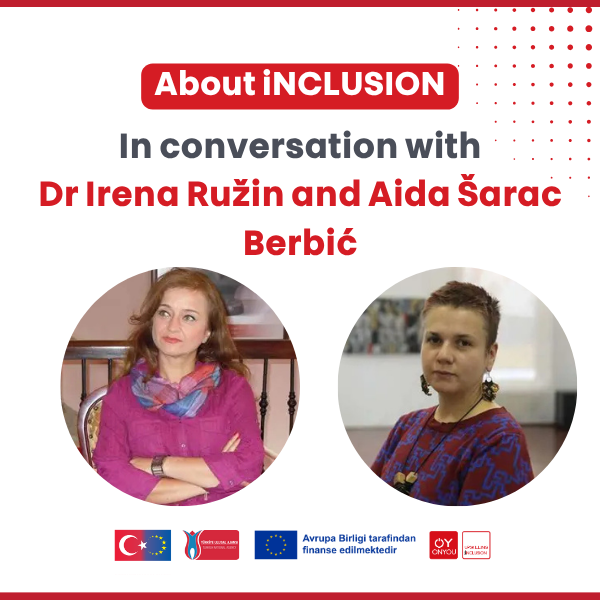In conversation with Dr. Irena Ružin and Aida Šarac Berbić
The iNCLUSION project—Upskilling Higher Education Students to Create Transformative Cultural Experiences for Audiences of Disabled People—is helping museums across the Balkans become more accessible, inclusive, and engaging for all. Two of the project’s leading voices, Dr. Irena Ružin and Aida Šarac Berbić, share their experiences, lessons learned, and advice for cultural institutions aiming to open their doors wider.
Irena Ružin: “Inclusion is a continuous process”
With over 30 years at the Institute and Museum Bitola in North Macedonia, Irena Ružin is a member of the Balkan Museum Network (BMN), the Balkan Museum Access Group (BMAG), and several other professional bodies. She describes her journey into accessibility work as transformative:
“Accessibility and inclusion in museums is a continuous process of learning, collaborating, evaluating, adapting, and implementing. As a member of the Balkan Museum Access Group, I literally started from zero. The iNCLUSION project—with a lot of love and dedication—opened up a whole new perspective for me.”
As part of the project, Irena participated in research, surveys, and study design, working directly with cultural professionals, disabled people, their parents, and special educators in Macedonia. She highlights training and study visists in Sarajevo (October 2024) with partners from Türkiye as particularly impactful:
“Our project partners explained the medical aspects of disability in detail, adding valuable context to the social model of disability we had previously applied. The knowledge transfer was incredibly important for shaping how cultural institutions can respond.”
Irena is also proud of presenting low-cost, good practices—developed with her colleague Jove Pargovski at the Institute and Museum Bitola.
“The iNCLUSION project is a continuation of efforts to make museums in our region more accessible and open to all through the education of students.”
Aida Šarac Berbić: “A happy, emotionally regulated child means a happy family”
Aida Šarac Berbić is a museum pedagogue at the Art Gallery of Bosnia and Herzegovina and an advocate for democratizing access to art. A member of ICOM, BMN, GEM, and the Forum of Slavic Cultures, she has dedicated her career to developing inclusive programs for disabled people, particularly those with developmental impairments.
“By creating inclusive experiences, museums show respect for human rights and diversity, and demonstrate social responsibility. For disabled people, such experiences open opportunities for socialization, boost self-confidence, foster creativity, and reduce stigma.”
In her work, Aida has witnessed powerful transformations:
“I’ve seen participants grow in self-worth through creating and interpreting art. In one project, the sale of their artworks even improved their economic situation. Activities for children with intellectual impairments have had a huge positive impact on their families—because a happy, emotionally regulated child means a happy family.”
Bridging Higher Education and Museums
One innovative aspect of the iNCLUSION project is connecting higher education students with cultural institutions.
“Future curators, educators, and creatives gain hands-on experience, while museums benefit from fresh perspectives,” Aida explains.
At the Art Gallery of Bosnia and Herzegovina, pedagogy students interned by assisting with programs for disabled children and young people. Students from the Academy of Fine Arts of the University of Sarajevo contributed to the visual identity of the assistive technology ARTsee, created animations, and photo-documented educational programs.
“The collaborations were mutually beneficial—students gained practical experience and networks, while museums received high-quality, creative outputs that improved accessibility.”
The Power of International Collaboration
For Irena, international partnerships are essential:
“Study visits to Ankara and Sarajevo generated new ideas, contacts, and partnerships. The museums involved gained international visibility and discovered innovative ways to interpret cultural heritage.”
She believes such projects provide practical tools for museums to attract new audiences and build inclusive environments:
“With proper training, museum staff and students develop the skills needed to work with marginalized groups. This is how museums can become leaders in accessibility.”
Lessons from the Art Gallery of Bosnia and Herzegovina
During the consortium’s study visit to the Art Gallery of Bosnia and Herzegovina, Aida emphasized several takeaways:
- Inclusion means co-creating with the target group, not just designing programs for them.
- Continuity matters more than expensive technology.
- Adapting methods to real needs, even on a small budget, can have long-term impact.
- Quality educational strategies outweigh costly equipment.
“A clear structure, sensitive dedication, and appropriate methods will always be more impactful than any gadget.”
What Will Determine Long-Term Success?
According to Aida:
“Inclusion must involve the entire institution, not just the staff members who are dealing with the audience. The process starts with identifying needs, creating quality digital content, and continuously testing and adapting it based on feedback from disabled people.”
Only deep, organization-wide engagement can ensure equal participation in cultural life.
Practical Advice for Cultural Institutions
Irena’s perspective:
- Start with education—know the human rights framework and relevant laws.
- Consult directly with disabled people to understand needs and expectations.
- Improve physical and sensory accessibility (signage, tactile exhibits, Braille, quiet rooms).
- Explore low-cost tech solutions like audio guides, VR, and 3D-printed replicas.
- Make your website accessible with high-contrast text, clear language, and audio options.
- Collaborate with other institutions and share best practices.
“Step by step, accessibility is improving—and it’s now a priority for every institution.”
Aida’s perspective:
- Inclusion is more than ramps and Braille—it requires a genuine shift in institutional attitudes.
- Conduct audience research to know who visits, who doesn’t, and why.
- Use outreach activities to engage communities beyond the museum walls.
- Adapt educational methods based on questionnaires, observations, and feedback.
- Involve typical peers alongside disabled people to prevent segregation.
The iNCLUSION project shows what’s possible when higher education, museums, and disabled communities collaborate. Thanks to dedicated experts like Dr. Irena Ružin and Aida Šarac Berbić, museums across the Balkans are taking concrete steps toward becoming truly inclusive spaces.

iNCLUSION project is funded by the EU through Erasmus programme.

